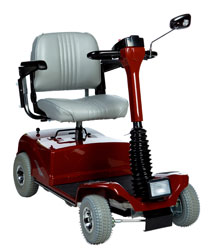Section navigation
Tools for daily living

Tools that help people with disabilities lead more independent lives are known as assistive technology, or AT. AT devices can help you move around, see, communicate, eat, or get dressed. Examples of AT devices that you might use in daily living include:
- A one-handed cutting board that has spikes to hold food in place while you cut it with one hand
- Motorized scooters
- Talking clocks
- Velcro fasteners on shoes
- A curved bath brush with a long handle that helps people with limited arm movement reach their back and other bathing spots
Finding and funding AT  top
top
If you need help locating AT devices and paying for them, here are some tips:
- Each state has an Assistive Technology Program. You can find your AT office and ask for help locating companies that sell AT. The AT office also may have a demonstration and loan center, where you can try out and borrow devices. The office also may be able to help with getting funding or loans for AT.
- Centers for Independent Living, community-based groups that help people with disabilities, may have suggestions for funding sources or organizations that lend equipment.
- If you qualify, Medicaid may pay for some AT.
- If you have health insurance, it may pay for some types of AT.
- If you get help from professionals like a special education teacher, physical therapist, or vocational rehabilitation specialist, they may know of resources.
- Some areas have AT exchanges, where people swap items they’re not using or sell them at lower prices. Click here to see if there’s an AT exchange near you.
- Organizations that focus on specific disabilities like cerebral palsy, blindness, and other conditions may offer financial assistance for assistive technology. They also often have helpful advice for making daily living easier. Check out our list of resources on specific illnesses and disabilities.
- Parent Training and Information Centers, which help parents of kids with disabilities, may have suggestions.
- Companies that sell AT devices may know how you can get help paying for their products.
- You could apply for assistance from the Disabled Children's Relief Fund. It helps fund orthopedic braces, hearing aids, eyeglasses, and other kinds of medical aids and treatments. It focuses special attention on children who don’t have any or enough health insurance.
Content last reviewed February 16, 2011
Page last updated October 31, 2013







